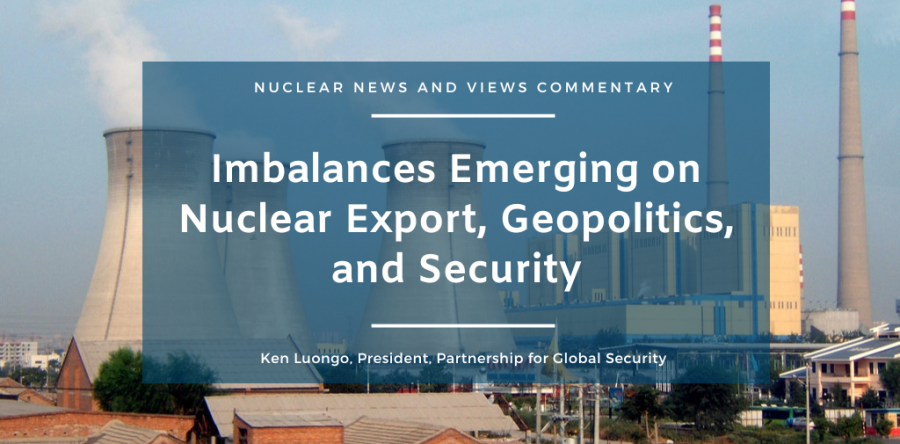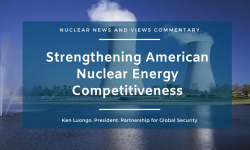Notable developments are occurring at the nexus of nuclear export, geopolitics, and global security driven by continuing and significant changes in the international environment. But as these issues further fuse and shape our future, it is not clear whether government policy and reactor market development can keep pace with the technology-centric next-gen nuclear trajectory. This policy-technology imbalance is a growing problem.
A recent article on China’s rise as a global nuclear power leader has been complemented by a new report on how that ascension is likely to create conflict with the U.S. This is particularly true in emerging markets for smaller reactors.
These stories both highlight the ambition of the U.S. to position itself as an alternative global nuclear supplier to China and Russia. But it is not clear that the government’s seemingly scattershot actions are adequate to match its stated ambition. There seemingly is not a strategic plan for locking down nuclear export markets.
One significant problem is that the very substantial funding being funneled by the U.S. government into new, smaller nuclear reactors is overwhelmingly for technology development and demonstration. There is little attention focused on the policies that will support these reactors or the cultivation of the markets where they will be deployed.
DoE has awarded $4.6 billion to three reactor designs, the Nuscale’s VOYGR, TerraPower’s Natrium, and X-energy’s Xe-100. The latter two reactors are funded out of the DoE Advanced Reactors Demonstration Program. Additional “Risk Reduction” funding for 5 other reactors added another $600 million to the investment.
Similarly, the U.K. this week announced it has chosen six companies designs for smaller nuclear reactors as part of a competition to deliver new nuclear plants to Britain by the mid-2030’s. These companies will now strive to receive government support and contracts by mid-2024.
Certainly, you need to design and demonstrate the new technologies before they can be deployed. But what is being shortchanged in the technology-driven process of the moment is the development of the policies and accurate market analysis that will support the realistic export and international competitiveness of these reactors.
These two issues are particularly important for the U.S. and other democratic nation nuclear suppliers.
Their next-gen reactors are likely to be more expensive than those produced by Russia and China. They also are unlikely to be able to match the financial subsidies that these authoritarian nations can offer developing economy nations. And they will be working with client countries that reside in less stable regions, like Africa and the Middle East. Russia and China already have made deep infrastructure inroads in these regions.
Therefore, besides being qualitatively superior, the western reactor suppliers need to offer an effective operational support and security policy package that strengthens international confidence in their reactor sales and operation. That responsibility likely is going to fall more heavily on governments as the reactor developers are mainly focused on managing their product and regulatory requirements.
But the national government response on these issues has been scattered and uncoordinated. An example of good intentions on the policy agenda, but lack of specifics, was a communique from the recent OECD “Roadmaps to New Nuclear” conference. It noted a commitment to “support the creation and maintenance of enabling policy frameworks, regulatory pathways, and codes and standards to enable nuclear energy deployment.” But it offered no specific action plan for the development of these vital items.
An important, if vague, policy step forward was taken by the IAEA in its the preprint release of its newest “Milestones in the Development of a National Infrastructure for Nuclear Power” report.
This document specifically addresses the applicability of the Agency’s 19 infrastructure issues, known as the “Milestones Approach”, for small and medium-sized modular reactors, particularly high temperature gas cooled reactors. It noted that, after several rounds of assessment, “it is expected that some elements of the infrastructure can be down scaled” because of lower power output and related risks. That is a significant statement, but offers no details.
The draft report further noted that for nuclear safeguards, the new reactor technologies, “may require the development of new approaches depending on the SMR design and type of fuel.” For nuclear security, it determined that, “It is not clear to what extent the complexity of the security arrangements for SMRs may be simplified.”
The need for evolving safeguards and security approaches for next-gen reactors was clearly identified by the Global Nexus Initiative's assessment of these technologies in 2019 and amplified in several subsequent analyses. Further official and expert work is necessary to build out the details of these preliminary analyses. Next-gen reactors are going to need an effective nuclear safeguards and security policy framework if they are to thrive.
A second challenge is to realistically scale nuclear power, both large and small, to meet climate objectives. The talk has intensified but the pathway is unclear as there are serious technical, regulatory, and financing issues to be addressed.
The U.S. climate Czar, John Kerry, noted during last month’s New York Climate Week, “we can’t get to net zero 2050 unless we have a pot, a mixture, of energy approaches in the new nuclear economy. And one of those elements which is essential in all the modelling I’ve seen, is nuclear.”
The new Net Zero Nuclear campaign, backed by the UAE and the UK, indicated that nuclear energy capacity needs to triple by 2050 to achieve global climate targets. That translates to 40 GW of new nuclear power per year, a requirement that vastly outstrips current deployment.
These developments were followed by the IAEA’s Nuclear Innovations for Net Zero scientific forum, held in Vienna last week. There, the U.S. Secretary of Energy dramatically raised the stakes for domestic nuclear deployment noting that, “reaching our 2050 net zero goals depends on at least tripling our nuclear energy capacity to 300 gigawatts or more.”
All of these statements are light years ahead of the tepid support for nuclear energy that pre-dated the Glasgow climate summit in 2021. There, the value of nuclear power as a significant carbon reduction technology along with renewables began to crystallize and gain international acceptance and momentum.
But the statements about the value of new nuclear sound more like the hope for achievement rather than the certainty of success. Failure cannot be an option given the climate and global security stakes. But success will not be achieved by rhetoric. Now is the time to bring the technology, policy, and market requirements into balance. The persistently airy nuclear buzz will lose its fizz if serious action isn’t taken now to lock down identifiable markets and begin to seriously prepare non-OECD countries for nuclear operation.
Spending billions on next-gen reactor technologies grabs headlines, consumes vast government resources, and offers supporters high level speech material. But the true measure of success will be the global market penetration of these reactors in the face of stiff competition from Russia and China. That’s not a talking point, it’s the reality.
Ken Luongo, President, Partnership for Global Security




